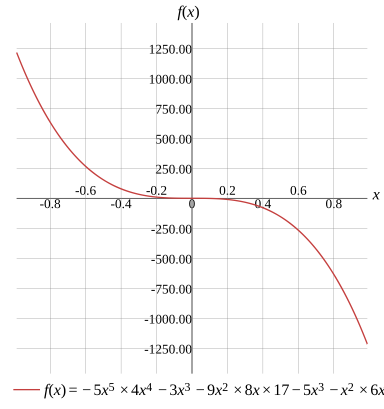Question
Function
Evaluate the derivative
Find the domain
Find the x-intercept/zero
Load more

f′(x)=−180x8−3696x2−42x6
Evaluate
f(x)=−5x5×4x4−3x3−9x2×8x×17−5x3−x2×6x5
Simplify
More Steps


Evaluate
−5x5×4x4−3x3−9x2×8x×17−5x3−x2×6x5
Multiply
More Steps


Multiply the terms
−5x5×4x4
Multiply the terms
−20x5×x4
Multiply the terms with the same base by adding their exponents
−20x5+4
Add the numbers
−20x9
−20x9−3x3−9x2×8x×17−5x3−x2×6x5
Multiply
More Steps


Multiply the terms
−9x2×8x×17
Multiply the terms
−1224x2×x
Multiply the terms with the same base by adding their exponents
−1224x2+1
Add the numbers
−1224x3
−20x9−3x3−1224x3−5x3−x2×6x5
Multiply
More Steps


Multiply the terms
−x2×6x5
Multiply the terms with the same base by adding their exponents
−x2+5×6
Add the numbers
−x7×6
Use the commutative property to reorder the terms
−6x7
−20x9−3x3−1224x3−5x3−6x7
Subtract the terms
More Steps


Evaluate
−3x3−1224x3−5x3
Collect like terms by calculating the sum or difference of their coefficients
(−3−1224−5)x3
Subtract the numbers
−1232x3
−20x9−1232x3−6x7
f(x)=−20x9−1232x3−6x7
Take the derivative of both sides
f′(x)=dxd(−20x9−1232x3−6x7)
Use differentiation rule dxd(f(x)±g(x))=dxd(f(x))±dxd(g(x))
f′(x)=−dxd(20x9)−dxd(1232x3)−dxd(6x7)
Calculate
More Steps


Calculate
dxd(20x9)
Use differentiation rule dxd(cf(x))=c×dxd(f(x))
20×dxd(x9)
Use dxdxn=nxn−1 to find derivative
20×9x8
Multiply the terms
180x8
f′(x)=−180x8−dxd(1232x3)−dxd(6x7)
Calculate
More Steps


Calculate
dxd(1232x3)
Use differentiation rule dxd(cf(x))=c×dxd(f(x))
1232×dxd(x3)
Use dxdxn=nxn−1 to find derivative
1232×3x2
Multiply the terms
3696x2
f′(x)=−180x8−3696x2−dxd(6x7)
Solution
More Steps


Calculate
dxd(6x7)
Use differentiation rule dxd(cf(x))=c×dxd(f(x))
6×dxd(x7)
Use dxdxn=nxn−1 to find derivative
6×7x6
Multiply the terms
42x6
f′(x)=−180x8−3696x2−42x6
Show Solution

Testing for symmetry
Testing for symmetry about the origin
Testing for symmetry about the x-axis
Testing for symmetry about the y-axis
Symmetry with respect to the origin
Evaluate
f(x)=−5x54x4−3x3−9x28x17−5x3−x26x5
Simplify the expression
f(x)=−20x9−1232x3−6x7
Rewrite the function using the appropriate notation
y=−20x9−1232x3−6x7
To test if the graph of y=−20x9−1232x3−6x7 is symmetry with respect to the origin,substitute -x for x and -y for y
−y=−20(−x)9−1232(−x)3−6(−x)7
Simplify
More Steps


Evaluate
−20(−x)9−1232(−x)3−6(−x)7
Multiply the terms
More Steps


Evaluate
−20(−x)9
Rewrite the expression
−20(−x9)
Multiply the numbers
20x9
20x9−1232(−x)3−6(−x)7
Multiply the terms
More Steps


Evaluate
−1232(−x)3
Rewrite the expression
−1232(−x3)
Multiply the numbers
1232x3
20x9+1232x3−6(−x)7
Multiply the terms
More Steps


Evaluate
−6(−x)7
Rewrite the expression
−6(−x7)
Multiply the numbers
6x7
20x9+1232x3+6x7
−y=20x9+1232x3+6x7
Change the signs both sides
y=−20x9−1232x3−6x7
Solution
Symmetry with respect to the origin
Show Solution

Graph
